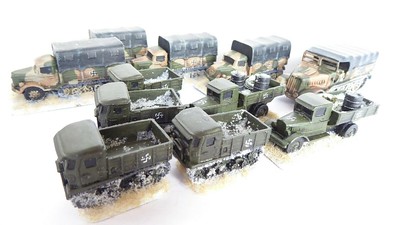It's fair to say that I lost my mojo for plastic model making. Because of my own OCD I tended to get a bit too obsessive about certain detail and often lost sight of the 'big picture'. This resulted is major 'burn out' and my subsequent near abandonment of this blog... 😥
However, a good example of this obsessiveness also happens to be the thing that is getting me to give military model making a second go! 😀
A long time ago (you know how it goes)... I got very obsessive about collecting a great many vehicles which were historically correct(-ish) for the Finnish 'Continuation War'. Most wargamers - because the game is the main thing - might compromise a bit on technical detail, I've seen a lot of Continuation War games played where the player 'makes do' with equipping the Finns with mainly German equipment with just a smattering of historically correct vehicles. A fair compromises as the Finns did actually use some German equipment.
 |
| A typical 'Flames of War' (15mm scale) compromise for a Continuation War war-game scenarios is the heavy use of German vehicles mixed in with a smattering of 'captured' Soviet trucks. |
But me...Oh boy. No, I had to collect just about every historically correct make and manufacturer of vehicle that the Finns actually used. As usual I went over the top...
Anyway, cutting to the chase - one of my major obsessions was the International Harvester K7 which was bought from the Americans in 1941, just before Finland technically changed sides and became a nominal member of the Axis coalition with Germany.
The K7 was a big truck - at least compared to many of the trucks the Finns had at their disposal - and was used as a 'heavy mover' for their larger artillery pieces. My problem (in 2017) was that there was no 1/72 models of this truck available and I ended up concocting all sorts of convoluted strategies for making one...
 |
| Above: The Soviet Zis-151. Here we can trace the development back from the Zil-157 closer to it's American origins... |
 |
| Above: The Zis-150, hardly distinguishable from the American K-7. |
In the end I discovered that the Soviet Zis-50 truck was a near exact copy of the K7s - which the Soviets received from the US as lend lease - BUT I didn't feel confident about scratch building the modifications needed to 'revert' this design to it's origins...
BUT THAT HAS CHANGED...
And here's where I explain what has got me back. Good old Santa has generously supplied me with a lovely gift of a FLASHFORGE ADVENTURER 3 3D PRINTER!
Hopefully this bit of kit will allow me to make a lot of the parts which stopped me from finishing some of my conversions and will allow me to build some of the more complex models that I wanted but couldn't even conceive of scratch building (or didn't want to just make do by using a 20mm scale model and pretend it was 1/72)!
I soon got the printer up and running and have produced a few test prints (just to check it was calibrated correctly and to see what it could do)...
Though, aside from downloaded third-party models, I have already started learning to create my own 3D models in a piece of software called TINKERCAD. I started simple by making the missing wheels I needed for my K7 conversion...
The above simple model is just a test object where I want to test the ability of my printer to adequately produce quite small detailed objects. This ability is unknown to me as so far my 'small' printed models (see above) have not been that small!
And the results? 👉
 |
| Printed in 'high' quality mode (only took 11 minutes)! Unfortunately, it's in that awful candy red PLA that comes with the printer to get you started... |
To get the detail in this tiny model to show up I sprayed the wheel with some grey primer. Although I am impressed with the resolution on this 'high' quality there are still tiny 'steps' where the model has been rendered in layers - typical of 3D printing. You can buy an automotive filler/primer which helps smooth out minor indentations, I'll have to try this next. But, really, I am pleased...
 |
| I was shocked to see that it had even picked out the tire tread! |
This was a very instructive exercise and has given me a lot of useful information which I can now carry forward onto the next stage. I think I can further simplify this design to help it print better and then, of course, I need to print out the full set of wheels. Then I can think about the other K7 parts I need to convert my Zil-157 model kit!
So, my journey begins...Again! 😁









welcome Back!
ReplyDeleteA very useful toy!
ReplyDelete